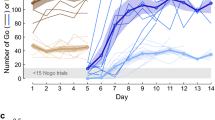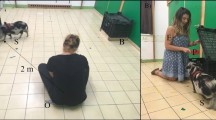Abstract
Social animals are always searching for conspecifics, thereby expressing a genuine “social need”. This need is illustrated by the fact that social isolation can induce isolation syndromes that can be attenuated by devices such as mirrors. Social contacts appear to be so vital for social animals that they may be ready to work to obtain social stimulations. We used operant conditioning to investigate the possibility to use visual contact (through pictures of conspecifics) as a primary reinforcer. Isolated European starlings (Sturnus vulgaris) were offered the choice of seeing either social images (i.e. pictures of conspecifics) or non-social images (i.e. pictures of landscapes or pictures of monkeys) by triggering sensors. In contrast with most studies, our subjects were presented still pictures of conspecifics and not videos. Moreover, these pictures were used as primary reinforcers and thus were not paired with food. Our data show that starlings were ready to work and to use the apparatus (i.e. sensors) to see pictures in the absence of any other reward. Moreover, they actively and significantly preferred pictures of conspecifics to pictures of inanimate objects (landscapes) or of heterospecifics (monkeys). This suggests that 2D pictures with a social overtone can be used as primary reinforcers for isolated social birds.





Similar content being viewed by others
References
Adret P (1993) Operant conditioning, song learning and imprinting to taped song in the zebra finch. Anim Behav 46:149–159. doi:10.1006/anbe.1993.1170
Adret P (1997) Discrimination of video images by zebra finches (Taeniopygia guttata): direct evidence from song performance. J Comp Psychol 111:115–125. doi:10.1037/0735-7036.111.2.115
Agrillo C, Piffer L, Bisazza A (2010) Large number discrimination by mosquitofish. PLoS One 5:e15232. doi:10.1371/journal.pone.0015232
Agrillo C, Piffer L, Bisazza A (2011) Number versus continuous quantity in numerosity judgments by fish. Cognition 119:281–287. doi:10.1016/j.cognition.2010.10.022
Appeltants D, Gentner TQ, Hulse SH et al (2005) The effect of auditory distractors on song discrimination in male canaries (Serinus canaria). Behav Processes 69:331–341. doi:10.1016/j.beproc.2005.01.010
Baenninger R, Mattleman RA (1973) Visual reinforcement: operant acquisition in the presence of a free mirror. Anim Learn Behav 1:302–306. doi:10.3758/BF03199257
Bovet D, Vauclair J (2000) Picture recognition in animals and humans. Behav Brain Res 109:143–165
Bullock DH, Smith WC (1953) An effect of repeated conditioning-extinction upon operant strength. J Comp Psychol 46:349–352. doi:10.1037/h0054544
Clergeau P (1981) Comportements liés à l’alimentation de l’étourneau Sturnus vulgaris en Bretagne: Rôle joué par certaines variables environnementales et sociales. Thèse de 3ème cycle, Rennes 1
Cloutier S, Newberry RC (2008) Use of a conditioning technique to reduce stress associated with repeated intra-peritoneal injections in laboratory rats. Appl Anim Behav Sci 112:158–173. doi:10.1016/j.applanim.2007.07.003
Collins SA (1999) Is female preference for male repertoires due to sensory bias? Proc R Soc B Biol Sci 266:2309–2314. doi:10.1098/rspb.1999.0924
Cook RG, Katz JS, Kelly DM (1999) Pictorial same-different categorical learning and discrimination in pigeons. Curr Psychol Cogn 18:805–843
Cousillas H, George I, Mathelier M et al (2006) Social experience influences the development of a central auditory area. Naturwissenschaften 93:588–596
Cousillas H, George I, Henry L et al (2008) Linking social and vocal brains: could social segregation prevent a proper development of a central auditory area in a female songbird? PLoS One 3:e2194
Delsaut M, Roy JC (1980) Auditory and visual stimuli as reinforcers among lovebirds (Agapornis roseicollis). Behav Neural Biol 28:319–334. doi:10.1016/S0163-1047(80)92315-8
Feare C (1984) The starling. Oxford University Press, Oxford
Feenders G, Bateson M (2012) The development of stereotypic behavior in caged European starlings, Sturnus vulgaris. Dev Psychobiol 54:773–784. doi:10.1002/dev.20623
Feinkohl A, Klump G (2011) Processing of transient signals in the visual system of the European starling (Sturnus vulgaris) and humans. Vision Res 51:21–25. doi:10.1016/j.visres.2010.09.020
Freeberg TM (1999) Spatial associations provide a context for social learning of courtship patterns in brown-headed cowbirds (Molothrus ater). J Comp Psychol 113:327–332
Gentner TQ (2004) Neural systems for individual song recognition in adult birds. Ann N Y Acad Sci 1016:282–302
Gentner TQ, Hulse SH (2000) Perceptual classification based on the component structure of song in European starlings. J Acoust Soc Am 107:3369–3381
George I, Alcaix S, Henry L et al (2010) Neural correlates of experience-induced deficits in learned vocal communication. PLoS One 5:e14347. doi:10.1371/journal.pone.0014347
George I, Richard J-P, Cousillas H, Hausberger M (2011) No need to talk, I know you: familiarity influences early multisensory integration in a songbird’s brain. Front Behav Neurosci 4:193. doi:10.3389/fnbeh.2010.00193
George I, Cousillas H, Richard J-P, Hausberger M (2012) Experience with adults shapes multisensory representation of social familiarity in the brain of a songbird. PLoS One 7:e38764. doi:10.1371/journal.pone.0038764
Giurfa M (2013) Cognition with few neurons: higher-order learning in insects. Trends Neurosci 36:285–294. doi:10.1016/j.tins.2012.12.011
Grassé P-P (1977) Précis de zoologie: vertébrés. Tome III, Reproduction, biologie, évolution et systématique: oiseaux et mammifères. Masson, Paris; New York; Barcelone [etc.]
Griffin GA, Harlow HF (1966) Effects of 3 months of total social deprivation on social adjustment and learning in the rhesus monkey. Child Dev 37:533–547. doi:10.2307/1126677
Hausberger M (1997) Social influences on song acquisition and sharing in the European starling (Sturnus vulgaris). In: Snowdon CT, Hausberger M (eds) Social influences on vocal development. Cambridge University Press, Cambridge, pp 128–156
Hausberger M, Richard M-A, Henry L et al (1995) Song sharing reflects the social organization in a captive group of European starlings (Sturnus vulgaris). J Comp Psychol 109:222–241
Henry L, Le Cars K, Mathelier M et al (2008) The use of a mirror as a `social substitute’ in laboratory birds. C R Biol 331:526–531. doi:10.1016/j.crvi.2008.04.005
Hinde RA (1973) Constraints on learning: an introduction to the problems. In: Hinde RA (ed) Constraints on learning. Academic Press, London, pp 1–19
Hinde RA (1976) Interactions, relationships and social structure. Man 11:1–17. doi:10.2307/2800384
Holden MD, Gregory J, Watkins V, Radford L (2006) Operant-conditioning programme for White rhinoceros, Black rhinoceros and Indian or Greater one-horned Asian rhinoceros. Int Zoo Yaerb 40:144–149. doi:10.1111/j.1748-1090.2006.00144.x
Hulse SH, Bernard DJ, Braaten RF (1995) Auditory discrimination of chord-based spectral structures by European starlings (Sturnus vulgaris). J Exp Psychol Gen 124:409–423. doi:10.1037/0096-3445.124.4.409
Langbein J, Siebert K, Nuernberg G, Manteuffel G (2007) The impact of acoustical secondary reinforcement during shape discrimination learning of dwarf goats (Capra hircus). Appl Anim Behav Sci 103:35–44. doi:10.1016/j.applanim.2006.04.019
Lazareva OF, Freiburger KL, Wasserman EA (2006) Effects of stimulus manipulations on visual categorization in pigeons. Behav Processes 72:224–233. doi:10.1016/j.beproc.2006.03.004
Leopold DA, Rhodes G (2010) A comparative view of face perception. J Comp Psychol 124:233–251. doi:10.1037/a0019460
Lihoreau M, Brepson L, Rivault C (2009) The weight of the clan: even in insects, social isolation can induce a behavioural syndrome. Behav Processes 82:81–84
Maier NRF, Schneirla TC (1935) Principles of animal psychology. McGraw-Hill Book Company, New York
Mason WA (1978) Ontogeny of social systems. In: Chivers DI, Herbert J (eds) Recent advances in primatology. Vol 1: behaviour. Academic Press, London, pp 5–14
McAfee LM, Mills DS, Cooper JJ (2002) The use of mirrors for the control of stereotypic weaving behaviour in the stabled horse. Appl Anim Behav Sci 78:159–173. doi:10.1016/S0168-1591(02)00086-2
McCall CA, Burgin SE (2002) Equine utilization of secondary reinforcement during response extinction and acquisition. Appl Anim Behav Sci 78:253–262. doi:10.1016/S0168-1591(02)00109-0
Miletto Petrazzini ME, Agrillo C, Piffer L et al (2012) Development and application of a new method to investigate cognition in newborn guppies. Behav Brain Res 233:443–449. doi:10.1016/j.bbr.2012.05.044
Okanoya K, Tsumaki S, Honda E (2000) Perception of temporal properties in self-generated songs by Bengalese finches (Lonchura striata var. domestica). J Comp Psychol 114:239–245
Olds J, Milner P (1954) Positive reinforcement produced by electrical stimulation of septal area and other regions of rat brain. J Comp Physiol Psychol 47:419–427. doi:10.1037/h0058775
Peissig JJ, Young ME, Wasserman EA, Biederman I (1999) The pigeon’s perception of depth-rotated shapes. Curr Psychol Cogn 18:657–690
Poirier C, Henry L, Mathelier M et al (2004) Direct social contacts override auditory information in the song-learning process in starlings (Sturnus vulgaris). J Comp Psychol 118:179–193
Reinhardt V (1991) Training adult male rhesus monkeys to actively cooperate during in-homecage venipuncture. Anim Technol 42:11–17
Richard-Yris M-A, Hausberger M, Henry S (2004) Bases éthologiques de l’apprentissage. 30ème Journée d’Etude de la Recherche Equine. Les Haras Nationaux, pp 179–187
Rodriguez A, Hausberger M, Clergeau P (2010) Flexibility in European starlings’ use of social information: experiments with decoys in different populations. Anim Behav 80:965–973. doi:10.1016/j.anbehav.2010.08.010
Saltzman IJ (1949) Maze learning in the absence of primary reinforcement: a study of secondary reinforcement. J Comp Physiol Psychol 42:161–173. doi:10.1037/h0059466
Sankey C, Henry S, Górecka-Bruzda A et al (2010) The way to a man’s heart is through his stomach: What about horses? PLoS One 5:e15446. doi:10.1371/journal.pone.0015446
Seki Y, Okanoya K (2008) Sex differences in audiovisual discrimination learning by Bengalese finches (Lonchura striata var. domestica). J Comp Psychol 122:26–34. doi:10.1037/0735-7036.122.1.26
Snowdon CT, Hausberger M (1997) Social influences on vocal development. Cambridge University Press, Cambridge
Sousa C, Matsuzawa T (2001) The use of tokens as rewards and tools by chimpanzees (Pan troglodytes). Anim Cogn 4:213–221. doi:10.1007/s100710100104
Swann WJ (2006) Improving the welfare of working equine animals in developing countries. Appl Anim Behav Sci 100:148–151. doi:10.1016/j.applanim.2006.04.001
Watanabe S (1999) How do pigeons see pictures? Recognition of the real world from its 2-D representation. Curr Psychol Cogn 18:691–711
Watanabe S, Yamashita M, Wakita M (1993) Discrimination of video images of conspecific individuals in bengalese finches. J Ethol 11:67–72. doi:10.1007/BF02350008
West MJ, King AP, Freeberg TM (1997) Building a social agenda for the study of bird song. In: Snowdon CT, Hausberger M (eds) Social influences on vocal development. Cambridge University Press, Cambridge, pp 41–56
Wilkinson A, Specht HL, Huber L (2010) Pigeons can discriminate group mates from strangers using the concept of familiarity. Anim Behav 80:109–115. doi:10.1016/j.anbehav.2010.04.006
Wisniewski AB, Hulse SH (1997) Auditory scene analysis in European starlings (Sturnus vulgaris): discrimination of song segments, their segregation from multiple and reversed conspecific songs, and evidence for conspecific song categorization. J Comp Psychol 111:337–350. doi:10.1037/0735-7036.111.4.337
Yin S, Fernandez EJ, Pagan S et al (2008) Efficacy of a remote-controlled, positive-reinforcement, dog-training system for modifying problem behaviors exhibited when people arrive at the door. Appl Anim Behav Sci 113:123–138. doi:10.1016/j.applanim.2007.11.001
Zimmerman DW (1957) Durable secondary reinforcement: method and theory. Psychol Rev 64:373–383. doi:10.1037/h0041885
Acknowledgments
We thank Christine Aubry for taking care of the birds, Noemie Templé and Sabrina Tartu for their contribution to the experiments, Ann Cloarec for English proofreading and editing and Arlette Streri, Martin Giurfa, Nathalie George, Luc Madec and Catherine Blois-Heulin for helpful comments on this study. This study was supported by a grant from the French A.N.R. (Agence Nationale pour la Recherche) entitled “Intermodality and imitation: behavioral and neuronal aspects (studies in human newborns and birds)”. All authors are supported by the University of Rennes 1 and by the French CNRS. Audrey Perret is a doctoral fellow of the French Ministry of Higher Education and Research. The authors declare no competing financial interests.
Conflict of interest
The authors declare no competing financial interests.
Author information
Authors and Affiliations
Corresponding author
Rights and permissions
About this article
Cite this article
Perret, A., Henry, L., Coulon, M. et al. Social visual contact, a primary “drive” for social animals?. Anim Cogn 18, 657–666 (2015). https://doi.org/10.1007/s10071-015-0834-8
Received:
Revised:
Accepted:
Published:
Issue Date:
DOI: https://doi.org/10.1007/s10071-015-0834-8




